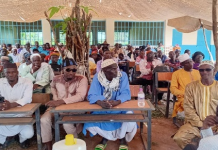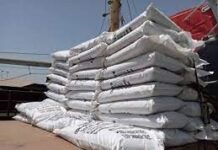With Abdoulie Dibba
This column is devoted to monitor and report on issues that are related  to food security in the Gambia as well as the interventions of Government and Non-governmental Organisations. In this edition, Farmers’Eye will explain what The Gambia National Agriculture Database entails with regard to its Users and Beneficiaries, Key features, How it works, and its benefits according to the lead consultant Mr Bho.
The lead consultant told the audience at the launch that the Gambia National Agriculture Database is creating a common source of reliable data for The Gambia Agriculture Sector.
He continues his presentation as follows:-
The Gambia National Agriculture Database, its Users and Beneficiaries
The Government of the Gambia and the International Fund for Agricultural Development (IFAD) jointly, funded the development of a database application called the Gambia National Agriculture Database (GANAD).
The GANAD is the heartbeat of a broader Agriculture Sector M&E system (Ag-sector PM&E), that is designed to capture, store, process and report diverse data types depicting implementation progress and results for MoA and its Ag-sector development partners.
The GANAD is centrally managed, enabling it to stand out as a “single common source of Ag-sector data” for all data requirements for national and Ag-sector planning.
It focuses mainly on capturing regular progress monitoring data (tracking implementation progress, outputs and immediate benefits, whereas most outcome and impact level data is captured through periodic surveys into SPSS for analysis.
Direct beneficiaries and users of the GANAD include all Ag-sector senior and middle level management (who can generate reports), the system Administrator (who administers the database and manage users), M&E staff (who can validate, approve and generate reports) and Data Entry staff (responsible for data entry only).
Other beneficiaries include Ministry of Finance and Economic Affairs, other government sectors and all development partners, who will only receive requested data.
KEY FEATURES OF THE GAMBIA NATIONAL AGRICULTURE DATABASE
The GANAD is based on Microsoft SQL Server 2008 (a relational database management system) and Visual Basic.NET, as the backend and frontend, respectively.
The GANAD currently run on a hard drive capacity of 1.5TB which can be upgraded when necessary.
It consists of a login screen and four main menu items: Administrator, Data Entry, Partner Reports and Ag-Sector Reports.
The GANAD has an easy to access menu system and user friendly interface, well delineated user and access rights at data entry, validation, approval and report generation, all controlled through user level user names and passwords.
The data entry menu has 15 modules i.e. Value Chain Actor (VCA) Registration, Horticulture, Livestock , Field Crops, Infrastructure, VCA Capacity Development, Staff Capacity Development, Budget Allocation, Service Provision, Fisheries, Natural Resources, Imports and Exports, NARI, ITC and Financial service, under which specific data is entered and can be viewed.
The GANAD has several setups and drop downs for II non-repetitive data for each module that allows only selection of the applicable options and minimal typing, for example all applicable crops species and varieties, livestock species and breeds, diseases, pests, drugs, pesticides, villages, districts, regions and many others have been set to allow selection instead of typing, at data entry level.
The Database Administrator is responsible for adding any newly identified and approved repetitive data and reports.
HOW DOES THE GANAD WORK?
All data that is entered is grouped by region, district, village, partner/funding source, value chain segment (business type), enterprise type and at lower levels by gender, age, crop/ livestock species etc.
The system captures bio-data for 3 categories of VCA, i.e. individuals, partnership and groups (institutions) and either a National Identity Number (NIN) or Registration Number is required as the unique ID, so as to minimise double registration of VCA and double counting.
Security features include, passwords, an audit trail module that tracks the activity history of every user to ensure accountability etc.
A data quality assurance feature also exists wherein the Central Projects Coordinating Unit/Planning Services Unit M&E Officer can only view and use data that the project and department level M&E Officers have validated and authorised for further viewing and use.
Data from regions can only be available when the regional M&E Officer/RAD has approved it. Thus, the system creates an opportunity for the Regional offices and Project Management Units to take full responsibility and ownership of the data that originates from their regions and projects.
THE BENEFITS OF THE GANAD
Both static and cumulative reports for specific date ranges can be generated immediately once data has been approved at project and department levels.
Several prescribed reports and many others can be generated in real time through the partner and Ag-sector level reports menus.
The typical report types are: crop, livestock and fish (production, yield, pest and diseases, sales and consumption & technology application); agro-VCAs reached with support and benefits thereof; number and type of infrastructure developed; area of land developed and conserved; service provision (extension, financial); budget allocation and natural resources managed and others.
Raw data or reports can be exported from GANAD into Excel and subsequently to other data analysis applications. GANAD data outputs can directly be saved as, and printed from Word and PDF formats.
GANAD is one-stop-shop for all Ag-sector progress monitoring data that is essential for evidence based resource allocation, planning, decision making and sector donor coordination.
The GANAD enables MoA and its partners to accurately and timely measure its implementation progress and the Ag-sector’s contribution to PAGE, MDG, and Vision 2020 objectives and targets.
The GANAD can be used to track extension service provision and activity of extension workers.
Although it doesn’t capture outcome and impact data, it provides the primary data that can be analysed to provide further quantitative facts during evaluations. It therefore reduces the time required for surveys and evaluations.
It is a one stop shop for Ag-sector progress monitoring data that can be accessed anywhere as long as there is internet connection and one has valid user rights!
]]>
to food security in the Gambia as well as the interventions of Government and Non-governmental Organisations. In this edition, Farmers’Eye will explain what The Gambia National Agriculture Database entails with regard to its Users and Beneficiaries, Key features, How it works, and its benefits according to the lead consultant Mr Bho.
The lead consultant told the audience at the launch that the Gambia National Agriculture Database is creating a common source of reliable data for The Gambia Agriculture Sector.
He continues his presentation as follows:-
The Gambia National Agriculture Database, its Users and Beneficiaries
The Government of the Gambia and the International Fund for Agricultural Development (IFAD) jointly, funded the development of a database application called the Gambia National Agriculture Database (GANAD).
The GANAD is the heartbeat of a broader Agriculture Sector M&E system (Ag-sector PM&E), that is designed to capture, store, process and report diverse data types depicting implementation progress and results for MoA and its Ag-sector development partners.
The GANAD is centrally managed, enabling it to stand out as a “single common source of Ag-sector data” for all data requirements for national and Ag-sector planning.
It focuses mainly on capturing regular progress monitoring data (tracking implementation progress, outputs and immediate benefits, whereas most outcome and impact level data is captured through periodic surveys into SPSS for analysis.
Direct beneficiaries and users of the GANAD include all Ag-sector senior and middle level management (who can generate reports), the system Administrator (who administers the database and manage users), M&E staff (who can validate, approve and generate reports) and Data Entry staff (responsible for data entry only).
Other beneficiaries include Ministry of Finance and Economic Affairs, other government sectors and all development partners, who will only receive requested data.
KEY FEATURES OF THE GAMBIA NATIONAL AGRICULTURE DATABASE
The GANAD is based on Microsoft SQL Server 2008 (a relational database management system) and Visual Basic.NET, as the backend and frontend, respectively.
The GANAD currently run on a hard drive capacity of 1.5TB which can be upgraded when necessary.
It consists of a login screen and four main menu items: Administrator, Data Entry, Partner Reports and Ag-Sector Reports.
The GANAD has an easy to access menu system and user friendly interface, well delineated user and access rights at data entry, validation, approval and report generation, all controlled through user level user names and passwords.
The data entry menu has 15 modules i.e. Value Chain Actor (VCA) Registration, Horticulture, Livestock , Field Crops, Infrastructure, VCA Capacity Development, Staff Capacity Development, Budget Allocation, Service Provision, Fisheries, Natural Resources, Imports and Exports, NARI, ITC and Financial service, under which specific data is entered and can be viewed.
The GANAD has several setups and drop downs for II non-repetitive data for each module that allows only selection of the applicable options and minimal typing, for example all applicable crops species and varieties, livestock species and breeds, diseases, pests, drugs, pesticides, villages, districts, regions and many others have been set to allow selection instead of typing, at data entry level.
The Database Administrator is responsible for adding any newly identified and approved repetitive data and reports.
HOW DOES THE GANAD WORK?
All data that is entered is grouped by region, district, village, partner/funding source, value chain segment (business type), enterprise type and at lower levels by gender, age, crop/ livestock species etc.
The system captures bio-data for 3 categories of VCA, i.e. individuals, partnership and groups (institutions) and either a National Identity Number (NIN) or Registration Number is required as the unique ID, so as to minimise double registration of VCA and double counting.
Security features include, passwords, an audit trail module that tracks the activity history of every user to ensure accountability etc.
A data quality assurance feature also exists wherein the Central Projects Coordinating Unit/Planning Services Unit M&E Officer can only view and use data that the project and department level M&E Officers have validated and authorised for further viewing and use.
Data from regions can only be available when the regional M&E Officer/RAD has approved it. Thus, the system creates an opportunity for the Regional offices and Project Management Units to take full responsibility and ownership of the data that originates from their regions and projects.
THE BENEFITS OF THE GANAD
Both static and cumulative reports for specific date ranges can be generated immediately once data has been approved at project and department levels.
Several prescribed reports and many others can be generated in real time through the partner and Ag-sector level reports menus.
The typical report types are: crop, livestock and fish (production, yield, pest and diseases, sales and consumption & technology application); agro-VCAs reached with support and benefits thereof; number and type of infrastructure developed; area of land developed and conserved; service provision (extension, financial); budget allocation and natural resources managed and others.
Raw data or reports can be exported from GANAD into Excel and subsequently to other data analysis applications. GANAD data outputs can directly be saved as, and printed from Word and PDF formats.
GANAD is one-stop-shop for all Ag-sector progress monitoring data that is essential for evidence based resource allocation, planning, decision making and sector donor coordination.
The GANAD enables MoA and its partners to accurately and timely measure its implementation progress and the Ag-sector’s contribution to PAGE, MDG, and Vision 2020 objectives and targets.
The GANAD can be used to track extension service provision and activity of extension workers.
Although it doesn’t capture outcome and impact data, it provides the primary data that can be analysed to provide further quantitative facts during evaluations. It therefore reduces the time required for surveys and evaluations.
It is a one stop shop for Ag-sector progress monitoring data that can be accessed anywhere as long as there is internet connection and one has valid user rights!
]]>


















